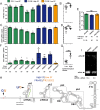Dengue subgenomic flaviviral RNA disrupts immunity in mosquito salivary glands to increase virus transmission
- PMID: 28753642
- PMCID: PMC5555716
- DOI: 10.1371/journal.ppat.1006535
Dengue subgenomic flaviviral RNA disrupts immunity in mosquito salivary glands to increase virus transmission
Abstract
Globally re-emerging dengue viruses are transmitted from human-to-human by Aedes mosquitoes. While viral determinants of human pathogenicity have been defined, there is a lack of knowledge of how dengue viruses influence mosquito transmission. Identification of viral determinants of transmission can help identify isolates with high epidemiological potential. Additionally, mechanistic understanding of transmission will lead to better understanding of how dengue viruses harness evolution to cycle between the two hosts. Here, we identified viral determinants of transmission and characterized mechanisms that enhance production of infectious saliva by inhibiting immunity specifically in salivary glands. Combining oral infection of Aedes aegypti mosquitoes and reverse genetics, we identified two 3' UTR substitutions in epidemic isolates that increased subgenomic flaviviral RNA (sfRNA) quantity, infectious particles in salivary glands and infection rate of saliva, which represents a measure of transmission. We also demonstrated that various 3'UTR modifications similarly affect sfRNA quantity in both whole mosquitoes and human cells, suggesting a shared determinism of sfRNA quantity. Furthermore, higher relative quantity of sfRNA in salivary glands compared to midgut and carcass pointed to sfRNA function in salivary glands. We showed that the Toll innate immune response was preferentially inhibited in salivary glands by viruses with the 3'UTR substitutions associated to high epidemiological fitness and high sfRNA quantity, pointing to a mechanism for higher saliva infection rate. By determining that sfRNA is an immune suppressor in a tissue relevant to mosquito transmission, we propose that 3'UTR/sfRNA sequence evolution shapes dengue epidemiology not only by influencing human pathogenicity but also by increasing mosquito transmission, thereby revealing a viral determinant of epidemiological fitness that is shared between the two hosts.
Conflict of interest statement
The authors have declared that no competing interests exist.
Figures







Similar articles
-
Dengue virus replicates and accumulates in Aedes aegypti salivary glands.Virology. 2017 Jul;507:75-81. doi: 10.1016/j.virol.2017.04.009. Epub 2017 Apr 18. Virology. 2017. PMID: 28431281
-
Flaviviruses Produce a Subgenomic Flaviviral RNA That Enhances Mosquito Transmission.DNA Cell Biol. 2018 Mar;37(3):154-159. doi: 10.1089/dna.2017.4059. Epub 2017 Dec 18. DNA Cell Biol. 2018. PMID: 29251994
-
Characterization of dengue virus 3'UTR RNA binding proteins in mosquitoes reveals that AeStaufen reduces subgenomic flaviviral RNA in saliva.PLoS Pathog. 2022 Sep 19;18(9):e1010427. doi: 10.1371/journal.ppat.1010427. eCollection 2022 Sep. PLoS Pathog. 2022. PMID: 36121894 Free PMC article.
-
Developing arbovirus resistance in mosquitoes.Insect Biochem Mol Biol. 2002 Oct;32(10):1333-43. doi: 10.1016/s0965-1748(02)00096-6. Insect Biochem Mol Biol. 2002. PMID: 12225924 Review.
-
Diagnostic methods for detection & isolation of dengue viruses from vector mosquitoes.Indian J Med Res. 2006 May;123(5):615-28. Indian J Med Res. 2006. PMID: 16873905 Review.
Cited by
-
Structures and Functions of the 3' Untranslated Regions of Positive-Sense Single-Stranded RNA Viruses Infecting Humans and Animals.Front Cell Infect Microbiol. 2020 Aug 27;10:453. doi: 10.3389/fcimb.2020.00453. eCollection 2020. Front Cell Infect Microbiol. 2020. PMID: 32974223 Free PMC article. Review.
-
Genetic Variation in the Domain II, 3' Untranslated Region of Human and Mosquito Derived Dengue Virus Strains in Sri Lanka.Viruses. 2021 Mar 5;13(3):421. doi: 10.3390/v13030421. Viruses. 2021. PMID: 33807922 Free PMC article.
-
New Insights into the Biology of the Emerging Tembusu Virus.Pathogens. 2021 Aug 10;10(8):1010. doi: 10.3390/pathogens10081010. Pathogens. 2021. PMID: 34451474 Free PMC article. Review.
-
A New Subclass of Exoribonuclease-Resistant RNA Found in Multiple Genera of Flaviviridae.mBio. 2020 Sep 29;11(5):e02352-20. doi: 10.1128/mBio.02352-20. mBio. 2020. PMID: 32994331 Free PMC article.
-
Exploring the genetic diversity of the 3' untranslated region (UTR) of Dengue virus.Virol J. 2025 Jun 18;22(1):197. doi: 10.1186/s12985-025-02800-z. Virol J. 2025. PMID: 40533782 Free PMC article.
References
-
- Bhatt S, Gething PW, Brady OJ, Messina JP, Farlow AW, Maoyes CL, et al. The global distribution and burden of dengue. Nature. 2013;496(7446):504–7. doi: 10.1038/nature12060 - DOI - PMC - PubMed
-
- Gubler DJ. The global emergence/resurgence of arboviral diseases as public health problems. Archives of Medical Research. 2002;33(4):330–42. doi: 10.1016/s0188-4409(02)00378-8 - DOI - PubMed
-
- Conway MJ, Colpitts TM, Fikrig E. Role of the vector in arbovirus transmission. Annual Review of Virology. 2014;1(1):71–88. doi: 10.1146/annurev-virology-031413-085513 . - DOI - PMC - PubMed
-
- Guzman MG, Harris E. Dengue. The Lancet. 2015;385(9966):453–65. doi: 10.1016/s0140-6736(14)60572-9 - DOI - PubMed
MeSH terms
Substances
LinkOut - more resources
Full Text Sources
Other Literature Sources
Medical

